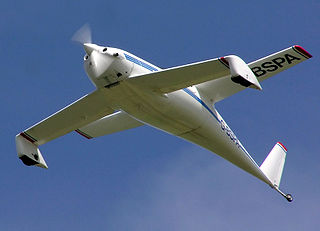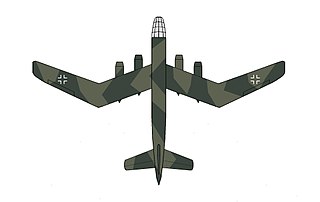A vertical take-off and landing (VTOL) aircraft is one that can take off and land vertically without relying on a runway. This classification can include a variety of types of aircraft including helicopters as well as thrust-vectoring fixed-wing aircraft and other hybrid aircraft with powered rotors such as cyclogyros/cyclocopters and gyrodynes.

The Blohm & Voss BV 155 was a German high-altitude interceptor aircraft intended to be used by the Luftwaffe against raids by USAAF Boeing B-29 Superfortresses. Work started on the design as the Messerschmitt Me 155 in 1942, but the project went through a protracted development period and change of ownership, and prototypes were still under test and development when World War II ended.
Hamburger Flugzeugbau (HFB) was an aircraft manufacturer, located primarily in the Finkenwerder quarter of Hamburg, Germany. Established in 1933 as an offshoot of Blohm & Voss shipbuilders, it later became an operating division within its parent company and was known as Abteilung Flugzeugbau der Schiffswerft Blohm & Voss from 1937 until it ceased operation at the end of World War II. In the postwar period it was revived as an independent company under its original name and subsequently joined several consortia before being merged to form Messerschmitt-Bölkow-Blohm (MBB). It participates in the present day Airbus and European aerospace programs.

A tandem wing is a wing configuration in which a flying craft or animal has two or more sets of wings set one behind another. All the wings contribute to lift.

The Emergency Fighter Program was the program that resulted from a decision taken on July 3, 1944 by the Luftwaffe regarding the German aircraft manufacturing companies during the last year of the Third Reich.

The Blohm & Voss Ha 142 was a German four-engined long-distance monoplane, developed to meet a Luft Hansa requirement for its transatlantic airmail service. The first of several prototypes flew on 11 October 1938 and they saw some service in other roles during the Second World War.
The Blohm & Voss BV 144 was an advanced twin-engined commercial airliner developed by Germany during World War II but intended for post-war service. It was unusual in having a variable-incidence wing. Two prototypes were built by Breguet in France.

The Supermarine Type 322 was a prototype British carrier-borne torpedo, dive bomber and reconnaissance aircraft of the Second World War. A single-engined monoplane, it was unsuccessful, with only two examples being built. The Fairey Barracuda, built to the same specification, would fill this role.

In aeronautics, a tailless aircraft is an aircraft with no other horizontal aerodynamic surface besides its main wing. It may still have a fuselage, vertical tail fin, and/or vertical rudder.
Richard Vogt was a military German aircraft designer who was known for his original airframes, including the asymmetrical BV 141 during World War II. After the war, he moved to the United States as part of Operation Paperclip, where he worked on American military aircraft design.

The wing configuration of a fixed-wing aircraft is its arrangement of lifting and related surfaces.
Asymmetrical aircraft have left- and right-hand sides which are not exact mirror images of each other. Although most aircraft are symmetrical, there is no fundamental reason why they must be, and design goals can sometimes be best achieved with an asymmetrical aircraft.

The Supermarine Type 525 was a British prototype naval jet fighter aircraft of the 1950s.
The Hamburger Flugzeugbau Ha 136 was an all-metal, single-seat training monoplane. It was the first design for the company by Dr. Richard Vogt and the first to feature his trademark tubular steel wing spar which doubled as the main fuel tank. Two prototypes were built but it was not ordered into production.

The Blohm & Voss Bv P 188 was a long-range, heavy jet bomber design project by the Blohm & Voss aircraft manufacturing division during the last years of the Third Reich. It featured a novel W-wing planform with variable incidence.
In aeronautics, bracing comprises additional structural members which stiffen the functional airframe to give it rigidity and strength under load. Bracing may be applied both internally and externally, and may take the form of strut, which act in compression or tension as the need arises, and/or wires, which act only in tension.
The Blohm & Voss P215 was an advanced jet night fighter project by Blohm & Voss during the Second World War. With a crew of three and twin jet engines, it featured a tailless swept-wing layout and heavy armament. An order for three prototypes was received just weeks before the war ended.
The Blohm & Voss P.202 was an unusual design study for a variable-geometry jet fighter during World War II. It was the first design to incorporate a slewed wing in which one side swept forward and the other back.
The Blohm & Voss P 193 was a design study for a dive bomber/ground attack aircraft intended to replace the Junkers Ju 87.









